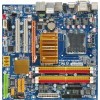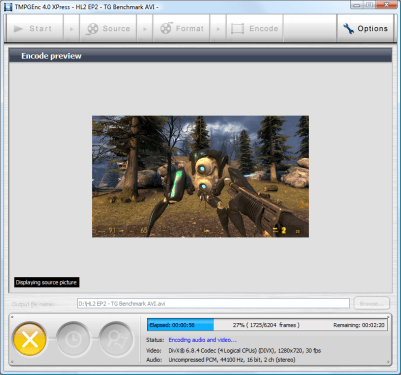- Qualcomm Launches Snapdragon 4 Gen 2 Mobile Platform
- AMD Launches Ryzen PRO 7000 Series Mobile & Desktop Platform
- Intel Launches Sleek Single-Slot Arc Pro A60 Workstation Graphics Card
- NVIDIA Announces Latest Ada Lovelace Additions: GeForce RTX 4060 Ti & RTX 4060
- Maxon Redshift With AMD Radeon GPU Rendering Support Now Available
Gigabyte EG45M-DS2H

On the test bench today, we have Gigabyte’s latest Micro ATX offering, the Intel G45-based EG45M-DS2H. This board carries the typical Gigabyte enthusiast charm, but also caters towards those looking to build a media center. But how does it stack up against the other Intel mATX boards we’ve tested recently?
Page 7 – Multimedia: DivX, 3ds Max 2009, Blu-ray Playback
Given the EG45M-DS2H’s positioning as a value-priced motherboard for media-center PC applications, we’ll be looking closely at how it performs under our set of multimedia tests, which are designed to test the board’s memory bandwidth and hardware acceleration features.
TMPGEnc 4.0 Express (DivX 6.8.4)
When it comes to video transcoding, one of the best offerings on the market is TMPGEnc Xpress. Although a bit pricey, the software offers an incredible amount of flexibility and customization, not to mention superb format support. For our test, we take a 0.99GB high-quality DivX H.264 AVI video of Half-Life 2: Episode Two gameplay with stereo audio and transcode it to the same resolution of 720p (1280×720), but lower the bitrate in order to attain a modest filesize. We’ve also enabled the DivX codec’s ‘Experimental Full Search’ feature using the highest level of the SSE instruction set that the processor supports.

Here we see that the Intel DG45ID and Gigabyte EG45M-DS2H both manage to edge out the ASUS P5E-VM, suggesting that the latest G45 drivers from Intel have managed to produce some performance gain. We tested all three boards with newer drivers than were used in last month’s review of the Intel DG45ID motherboard, and it’s clear that both G45-based boards have benefited from that. The Gigabyte board doesn’t outperform the Intel board here, however.
Autodesk 3ds Max 2009
Autodesk’s 3ds Max is without question an industry standard when it comes to 3D modeling and animation, with DreamWorks, BioWare and Blizzard Entertainment being a few of its notable users. It’s a multi-threaded application that’s designed to be right at home on multi-core and multi-CPU workstations or render farms. In our testing, we use a model that is supplied with the program, of the interior of a bathroom. The scene is rendered as a single frame at a resolution of 1920×1080 (1080p) using NVIDIA’s Mental Ray ray-tracing renderer, and the overall rendering time for the scene is recorded.

The Gigabyte EG45M-DS2H outperforms the DG45ID here, but still slips behind the ASUS P5E-VM in this test. Likely, memory bandwidth is the culprit here.
Arcsoft TotalMedia Theatre (Blu-ray Decoding)
Hardware acceleration of high-definition video decoding plays a large part in the Blu-ray experience on your PC, offloading the decoding task from the CPU and ensuring stutter-free and artifact-free HD playback. In light of this, we’ve incorporated a Blu-ray playback test that compares CPU usage in ArcSoft’s TotalMedia Theatre player while playing a specific scene from Disney’s Pirates of the Caribbean: At World’s End, which is a Blu-ray movie encoded in the H.264 format.
For comparison’s sake, we’ve also tested the motherboard under review with our reference NVIDIA GeForce 9600GT discrete GPU, which also supports hardware acceleration of HD video.

As you can see, having an IGP that’s capable of HD video acceleration can make a big difference in CPU usage – simply compare the performance of both Intel G45-based boards with the lone G35-based board, which doesn’t support HD video acceleration at all. The EG45M-DS2H comes up marginally shy of the Intel DG45ID’s performance in this regard, but having a discrete GPU providing acceleration is by far the best arrangement.
Support our efforts! With ad revenue at an all-time low for written websites, we're relying more than ever on reader support to help us continue putting so much effort into this type of content. You can support us by becoming a Patron, or by using our Amazon shopping affiliate links listed through our articles. Thanks for your support!







